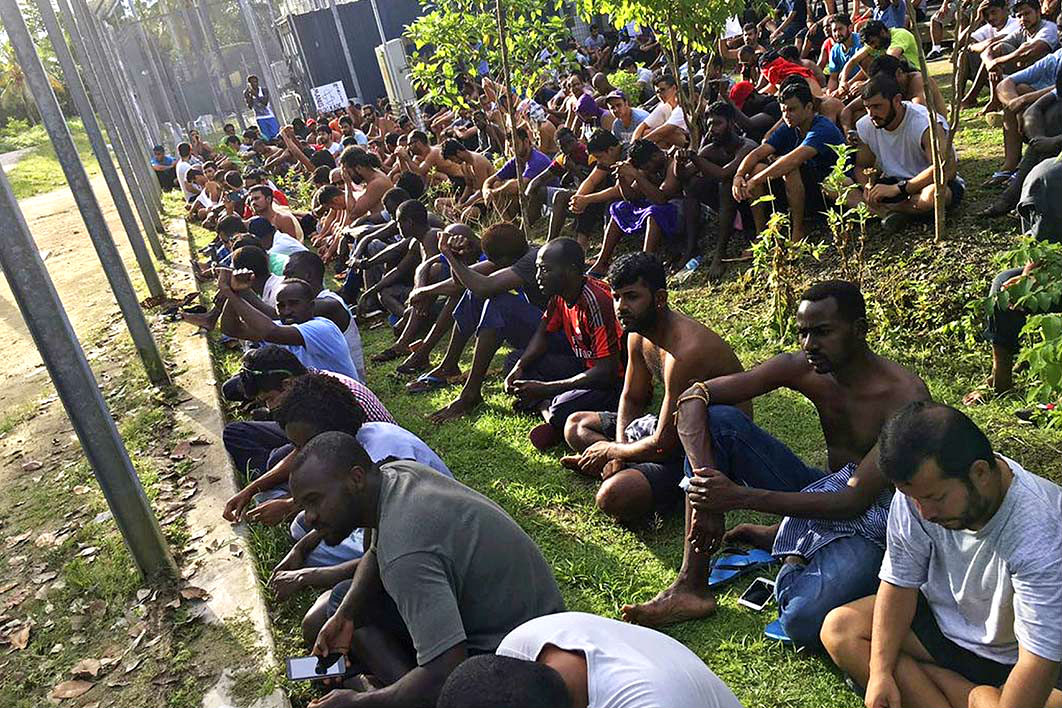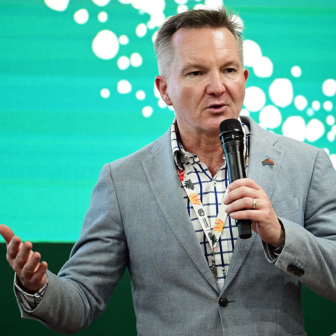Back in October 2005, Australia confronted a looming humanitarian emergency not too different from the one the United Nations High Commissioner for Refugees, or UNHCR, says is unfolding on Manus Island now. A group of asylum seekers had been held for roughly the same four-year-plus period on Nauru as those now on Manus, and the Coalition government was being implored to act.
Back then, the number of remaining asylum seekers on Nauru was just twenty-seven, far fewer than the almost 800 on Manus today. Over time, more than 700 had been resettled in Australia, notwithstanding the Howard government’s pledge that they would never be given permanent residency here. The last twenty-seven were in such a bad way that the psychiatrist employed by the International Organization for Migration, which managed the centre, warned that she would not be responsible if any of them resorted to suicide.
John Howard’s immigration minister, Amanda Vanstone, responded by despatching a team of mental health experts to Nauru, who duly supported the psychiatrist’s call for the asylum seekers to be evacuated. Led by Paris Aristotle from the Victorian Foundation for Survivors of Torture, the team reported that a number of the asylum seekers had “a history of suicide attempts and incidents of self-harm,” and identified “extreme levels of hopelessness and worthlessness” as major indicators of the suicide risk.
The minister made no mention of those findings when she announced on 14 October 2005 that all but two of the asylum seekers would be granted visas to come to Australia. Rather, she attributed the decision to “the government’s constant review of the failed asylum seekers caseload.”
Thirteen of the group were found to be genuine refugees, and the rest were given humanitarian visas, a move Vanstone said was “consistent with the government’s flexible approach to managing complex caseloads.” Her announcement on 14 October 2005 didn’t prompt any serious attempt by people smugglers to restart their trade.
There are six differences between that situation and what we see today, and they help explain why we are faced with what the UNHCR has correctly called an “escalating crisis.”
The first is that the numbers are much, much greater this time, especially when the number of refugees and asylum seekers on Nauru — well over a thousand — is added to the count.
The second is the government’s refusal to respond to the many warnings about the psychological state of those who came seeking Australia’s protection and the likelihood they will take extreme action.
In September last year, Aristotle implored the Turnbull government to remove asylum seekers from Nauru and Manus Island quickly or face the “high likelihood” that “many more men and women will express their despair by attempting to harm and kill themselves.” His concern was supported by a study by three mental health experts sent to Nauru and Manus by the UNHCR earlier last year. They found rates of depressive or anxiety disorders and post-traumatic stress disorder among asylum seekers and refugees on Manus Island “amongst the highest recorded rates of any surveyed population.”
In stark contrast to what happened in 2005, the warnings were ignored. What is more, the bleak predictions of suicides have come to pass. Two suicides have been reported in recent months on Manus, bringing to six the number of asylum seekers who have died after being transferred against their will to Papua New Guinea. The two most recent deaths followed constant expressions of concern by fellow detainees and advocates about the adequacy of mental health services.
The third difference is the government’s total refusal to yield to pragmatism and its blind adherence to the proposition that any display of compassion will be a green light to the people smugglers. This is despite the fact that there hasn’t been a successful boat arrival since well before the deal to resettle up to 1250 detainees in the United States was announced twelve months ago today.
Having secured that agreement with the Obama administration, the government had the opportunity to maximise the prospects of as many detainees as possible by helping them to present their cases; to secure a durable solution for 150 others by accepting a longstanding offer from New Zealand; to transfer those most damaged by their period in detention to Australia for medical treatment (as well as those with direct family links); and to revive efforts to find other resettlement places in Canada and elsewhere.
Immigration minister Peter Dutton could have borrowed Vanstone’s language and portrayed such action not as a softening of policy but, rather, as being “consistent with the government’s flexible approach to managing complex caseloads.” Instead, he has stuck to the strategy of trying to force asylum seekers to return to their country of origin by offering them no hope and no support and insisting the only other option for those on Manus not accepted by the United States is to stay in Papua New Guinea.
The “extreme vetting” of applications by the Americans has been extraordinarily slow, and the pressure on the refugees has escalated with the premature removal of services from the detention centre at Lombrum and the instruction that detainees must move to accommodation the UNHCR says is not yet ready, in an area the asylum seekers insist, with justification, is not safe.
Moreover, the offer from New Zealand has again been rejected, or at least put on indefinite hold, despite the fact that there is no evidence to support the current minister’s concern that it could enable the refugees to come to Australia through the back door — and despite the fact that the US deal and the offer of 150 resettlement places from New Zealand will not cover the refugee caseload.
Mr Dutton needs to be asked how many of the refugees accepted by New Zealand during the Howard years have moved to Australia. The answer is that the overwhelming majority settled very successfully in that country and have no desire whatsoever to move here. The back-door argument simply doesn’t stack up.
The fourth difference in 2005 was that Howard was more or less unassailable as leader of his party, having secured four election victories. Malcolm Turnbull’s leadership, on the other hand, is imperilled. His minister shows all the signs of wanting to advance his own leadership aspirations — and ward off any threat to his re-election in his Queensland seat from the left (GetUp!) and the right (Pauline Hanson) — by presenting himself as the unbending defender of the country’s borders.
The fifth difference is that, back in 2005, a group of Coalition MPs was prepared to challenge the prime minister on the treatment of asylum seekers, even to the point of crossing the floor. Led by Petro Georgiou, they included Russell Broadbent, Judi Moylan, Judith Troeth and Bruce Baird, and they had the support of others including Mal Washer and the National Party’s John Forrest.
Now, Broadbent is virtually the sole dissenting voice in the Coalition party room. He has made it clear that he is profoundly unhappy with the situation, but the stakes of crossing the floor are simply too high, as it could bring down the government.
This leads to the sixth and final difference: back then, there was strong support within the Labor opposition for a more compassionate and flexible approach, led by Carmen Lawrence, the former premier of Western Australia.
Since before the defeat of the Rudd government in 2013, Labor’s criticisms of the government’s treatment of those on Manus and Nauru have been hollow because of its own refusal to entertain the idea that anyone from Manus or Nauru will be resettled in Australia, including the fathers whose wives and children have been living in the Australian community for years.
The prospects for a swift end to the unfolding crisis and what the UNHCR has called the “unconscionable human suffering” of those on Manus are further diminished by the complexity of the situation on the ground and the history of the detention centre.
From the outset, rather than educate the detainees and the locals about each other’s culture and build trust and understanding, a deliberate effort was made to instil suspicion and even hostility. The escalation of tensions could easily result in violence, especially if police carry out their threat to remove people forcibly from the detention centre. More lives could be put at risk and Donald Trump might take the opportunity to drop what he has described as a “disgusting” and “horrible” deal he would never have made himself.
So what should happen now? The immediate challenge is to end the stand-off between those refusing to leave the centre and those who say they must move to the new accommodation at Lorengau, the only town in the province. The refugees’ insistence, backed by advocates in Australia, is that they will remain in the centre until a third country is found. It will not be acceded to. But their concerns about the state of the alternative accommodation, security and medical services in Lorengau are well-founded.
What is needed urgently is for a person of independence and integrity to be given the job of brokering a kind of truce, or at least a de-escalation, that would involve the refugees and asylum seekers moving out of the detention centre to the new accommodation, but only when it is clearly established that their concerns about security and essential services have been addressed. The independent mediator could also seek commitments that every effort is being made to assist those with applications for resettlement in the United States and restore some hope among the refugees that an end is in sight.
There is no one better qualified to perform this task than the former High Court judge Michael Kirby, whose global mediation, dispute resolution and human rights credentials are impeccable.
This, of course, is not a solution, not by any stretch, but it could break the impasse. A real solution will require pragmatism, courage, goodwill and compassion in equal measure, when all we have seen thus far is rigidity, fear, bad faith and malevolence. ●




